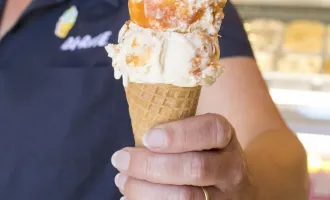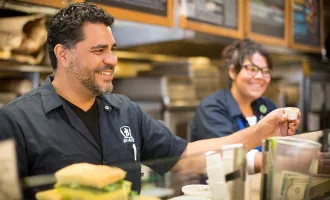No Whey! Artisan Cheese Tour At Cowgirl Creamery
This summer I spent quite a bit of time in Kenya, which, like much of the rest of Africa, casts a wary eye on cheese and cheese products. So, when I returned to San Francisco, I decided I needed a cheese binge. What better place to start than a tour of Marin County’s famed Cowgirl Creamery?
On a Wednesday morning, a classmate and I decided to skip lecture in favor of an hour-long guided tour in Petaluma (eating microbes is the same as learning about them, right?).
When we arrived, we sat in a room with about fifteen other people, including a group of Italian-speaking dairy farmers. The tour began with a mini-lecture taught by none other than Vivian Straus of Straus Family Creamery, a renowned local dairy farm.
Straus gave us a whirlwind tour of the history of artisanal cheese-making in Northern California. Cowgirl Creamery was founded by Peggy Smith and Sue Conley in 1997 and uses milk from local dairies in western Marin and Sonoma counties. There used to be more than 200 small dairy farms in the area, but there are less than 50 now, and the number continues to dwindle. Ten minutes into her talk, Straus presented us with our first sample: cups of clabbered cottage cheese accompanied by slices of fresh strawberry.
I used to think cottage cheese was something to be dreaded, but this was different—it had a squeaky-clean flavor and a firm texture. Combined with the ripe strawberries, the taste was divine.
Then we were treated to a hands-on demonstration of how cheese is made. Straus showed us how to separate curds from whey, using some plastic molds. Their cheese is made out of the curds, and is aged for varying amounts of time depending on the type. Cowgirl Creamery produces three types of soft cheeses and six dry ones. The most popular is called Mt. Tam, named for Mount Tamalpais in Marin County, and is crafted using a closely guarded secret recipe.
Our tour group moved in front of a giant glass window where we could see two 400-liter churners hard at work making the base for Mt. Tam. We were able to see Miguel, one of the cheese makers, as he tended to his latest batch. At this point, we were given slices of fresh cheese to taste. Because it hadn’t aged, it tasted a bit salty and had a cobbled texture, but Straus assured us it would change. The best cheese makers apparently possess the ability to sample their product at any point during the process and determine what to add or alter. I possess no such ability but was happy just to eat whatever delicious tidbit Straus placed in front of me.
At our next stop, we viewed hundreds of rounds of cheese being aged on racks. In the middle of the room, several workers were rolling some fresh rounds in a mushroom and herb mixture. This was “Chimney Rock,” Straus explained, a new seasonal cheese that was due out in a few weeks. It’s a good thing public decorum and a foot-thick glass wall separated me from those rounds, because I would have plowed through lesser barriers to get my hands on them.
Throughout her talk, Straus kept producing new platters of cheese samples for us to try. I tasted slices of Mt. Tam at varying points in the aging process—one week, two weeks, four weeks, and the final product.
Mt. Tam cheese is deliciously creamy (like Brie) but has a distinct buttery flavor. I also tasted wedges of Pt. Reyes, a silky cheese washed in wine and covered in herbs, and the delightfully pungent Red Hawk. As a medical student (who by definition is attracted to free food), I am not at all ashamed to admit that I happily cleared the sample tray of all extras.
At our last stop, I saw one employee inspecting each wheel for quality and another wrapping each of the cheese wheels by hand in special paper and placing them into boxes for export.
Cowgirl Creamery in Petaluma (there is another factory in Point Reyes and a retail stand in the Ferry Building) employs only a dozen people but churns out about 4,000 wheels of cheese per week.
At the end of the tour, each person was given a refrigerated satchel to take home. Inside our goodie bag, I found a whole wheel of Mt. Tam (retail: $18) and a tub of fromage blanc, a French-style cream cheese. We also got a few issues of glossy-looking cheese magazines (I didn’t know there was enough going on in the cheese world to publish periodicals about it), and a brochure mapping out the “Cheese Trail” in Sonoma County (think wine tasting, but focusing on cheese).
When I initially signed up for the tour, I was a bit apprehensive about the $30 fee, but the tour more or less pays for itself if you count the loot you get at the end.
With the beautiful weather and the taste of good food in my mouth, I was pleased with my experience at Cowgirl Creamery. As I was leaving, I asked Straus if she eats cheese every day. She defensively replied with a “No!” and then a few seconds later, sheepishly admitted that yes, there were few days that went by that were cheese-free for her. “In fact, it took me three years before I could walk past a Mt. Tam wheel and not sample some,” she said.
That’s certainly a strong testimonial. If you haven’t yet, go to your local grocery store and give your tastebuds a chance to taste one of the best cheeses in San Francisco, if not the state.
Cowgirl Creamery
419 First St.
Petaluma, CA 94952
Tour: Wednesdays at 11:30 a.m.
Cost: $30, free parking
Included: Hour-long tour with guided tastings and a take-home satchel of cheese
Reservations: Required


